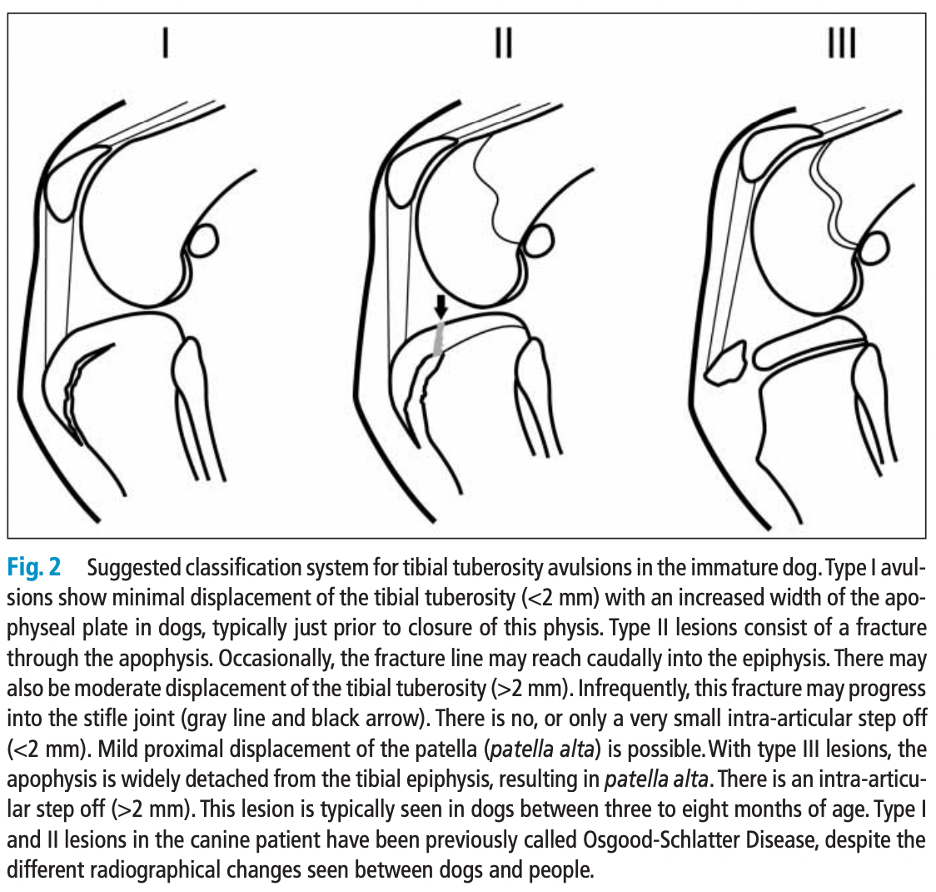Laurie's Blogs.
Jul 2022
Tibial Tuberosity Avulsion

In reading a ‘human’ blog on apophyses in adolescent athletes, I was reminded of a case I saw years ago. It was a young Borzoi that was lame in a hind limb. Details of how the dog had gotten to me are sketchy as, this was perhaps 15 years ago now… however I do remember my evaluation of this dog. Mostly because my presumption of the problem turned out to be wrong, and often we learn more from those cases than the ones we get right!
So, what I remember clearly was that when I was performing the Ortolani test on the dog, he exhibited signs of pain. He was consistent with this. However he had full hip ROM, and no pain on palpation of the soft tissue structures at the hip (i.e. the deep gluteal or the pectineus). It was curious. Finally, a full round of x-rays revealed an avulsion of the tibial tuberosity – Osgood-Schlatter disease! Why had my presumed ‘hip test’ show positive for pain? Because of where my hand was placed in order to perform the Ortolani test! So, I learned that in order to make sense of any one finding on a physical exam, you need to really put multiple factors into your deductive reasoning! (Fast forward, the dog made a full recovery with rest.)
So, it got me thinking about avulsion of the tibial tuberosity (aka Osgood-Schlatter disease (OSD) or syndrome, traction apophysitis of the tibial tubercle (ATT) or patellar tendon enthesopathy of the tibial tuberosity respectively) in dogs. Naturally, I went to Pubmed first, to see what I could find.
A 2009 paper (von PFeil et al) stated the following:
“Osgood-Schlatter disease (OSD) is a condition affecting human adolescents in which there is partial separation of bone fragments from the tibial tuberosity at the site of insertion of the patellar ligament to the tibial tuberosity. Tensile trauma seems to be the most likely aetiology.” “The term OSD has also been used for the canine patient. However, radiographs of these patients typically show an enlarged radiolucent line at the apophyseal plate of the tibial tuberosity. This finding is consistent with a mild avulsion fracture of the canine tibial tuberosity. Based on the radiographic differences between the two species, it seems more appropriate to use the term OSD only for people.”
One case report dating back to the mid 90’s documented the incidence of tibial tuberosity avulsions in a litter of Greyhound puppies. As such, a hereditary predisposition is postulated. However, another studies reported that trauma may precede avulsion, and a third studied concluded that avulsions seem to occur especially in dogs with steep angles of inclination of the tibial plateau, in the range of 35–55 degrees.
The von Pfeil study noted a classification system of tibial tuberosity avulsions be as follows. It makes sense, since not all ‘avulsions’ are the same.
All in all, the point of this blog is just to capture a little bit of information on the topic of tibial tuberosity avulsions and to bring awareness about this condition. Of note, surgery is recommended for the Type 2 and Type 3 cases. Whereas conservative management would benefit the Type 1 cases.
References:
Nehrbass D, Arens D, Zeiter S. Spontaneous bilateral avulsion fracture of the tuberositas tibiae in a New Zealand White rabbit - a counterpart to Osgood-Schlatter disease in humans? Exp Toxicol Pathol. 2015 Feb;67(2):223-7.
von Pfeil DJ, Decamp CE, Diegel KL, Gholve PA, Probst CW, Dejardin LM. Does Osgood-Schlatter disease exist in the dog? Vet Comp Orthop Traumatol. 2009;22(4):257-63.
Skelly CM, McAllister H, Donnelly WJ. Avulsion of the tibial tuberosity in a litter of greyhound puppies. J Small Anim Pract. 1997 Oct;38(10):445-9.
Clements DN, Gemmill T, Corr SA, Bennett D, Carmichael S. Fracture of the proximal tibial epiphysis and tuberosity in 10 dogs. J Small Anim Pract. 2003 Aug;44(8):355-8.
Power JW. Avulsion of the tibial tuberosity in the greyhound. Aust Vet J 1976; 52(11): 491–495.


